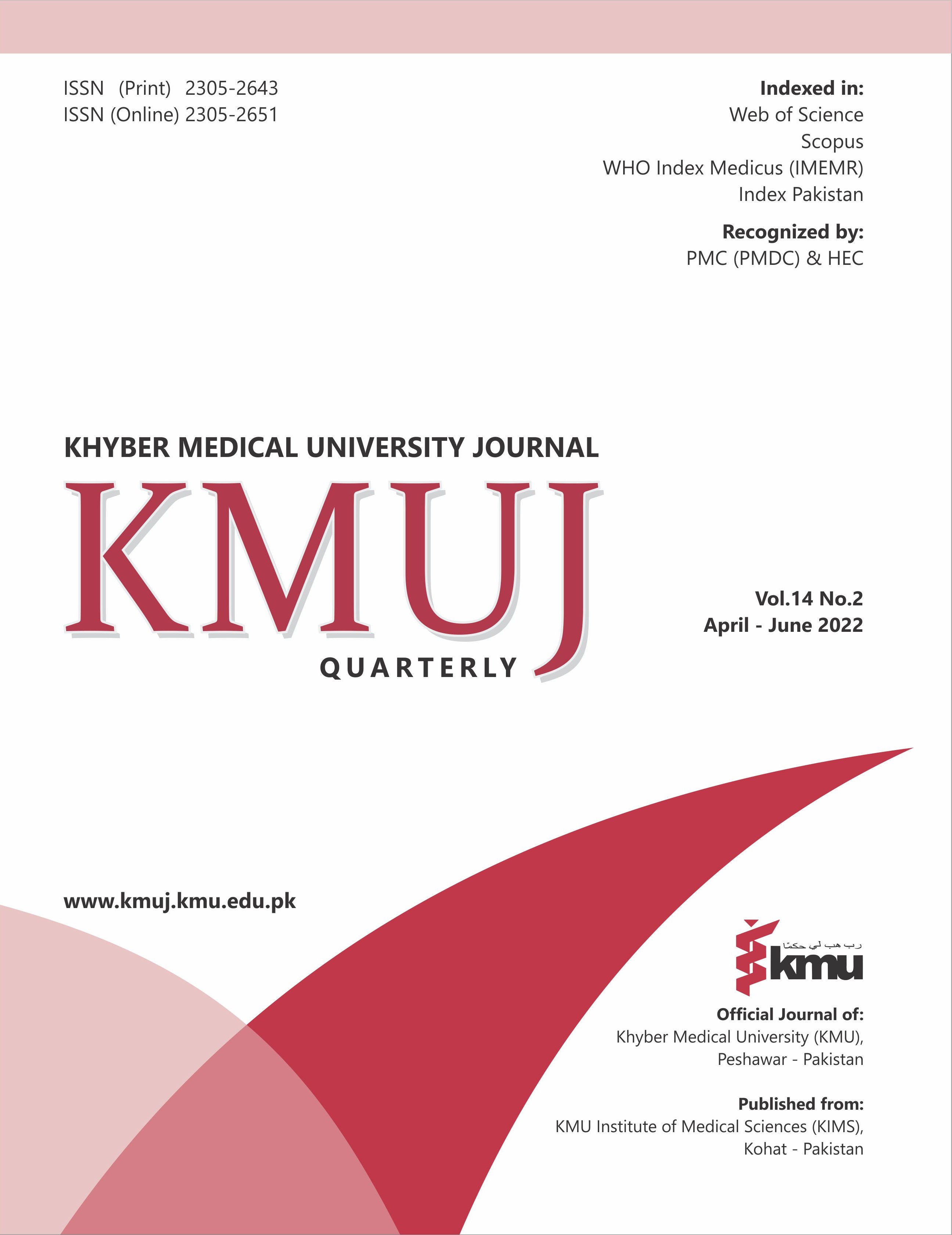ROLE OF PARENTAL SUSPICION OF HEARING IMPAIRMENT ON AGE OF DIAGNOSIS & INTERVENTION: A PAKISTANI PERSPECTIVE
Main Article Content
Abstract
OBJECTIVE: To determine the role of parental suspicion of hearing impairment (HI) on age of identification and intervention.
METHODS: This Retrospective chart review, reviewed medical records of hearing-impaired children of both genders, aging 6 months to 12 years, who attended Cochlear Implant Centre, Department of Otolaryngology, Capital Hospital, Islamabad, Pakistan from 1st July 2015 to 31st June 2016. Data extracted from medical records included basic demographic information and facts like when hearing loss was suspected, who suspected hearing loss, which professional conducted the first assessment, when was final diagnosis established and when did child receive intervention.
RESULTS: Out of 81 hearing impaired children, Majority (n=55; 67.9%) were males. Most (n=62; 76.5%) of the patients were suspected to have HI by parents and 56 (69.2%) were suspected to have HI in first year of life. In 67 (82.7%) cases, diagnosis was made within the first two years of life. Forty two (42.9%) patients received intervention in the first two years of life. There was significant association of age of suspicion of hearing impairment by parents with the age at diagnosis (p<0.001) and age at intervention (p<0.001) with those in whom HI was suspected earlier were able to be diagnosed and received intervention at an earlier age. No significant association was found for age of suspicion, age of diagnosis and age of intervention with persons who suspected HI and gender of the patients.
CONCLUSION: Parental suspicion of hearing impairment has significant role to play in the early diagnosis as well as intervention.
Article Details
Work published in KMUJ is licensed under a
Creative Commons Attribution 4.0 License
Authors are permitted and encouraged to post their work online (e.g., in institutional repositories or on their website) prior to and during the submission process, as it can lead to productive exchanges, as well as earlier and greater citation of published work.
(e.g., in institutional repositories or on their website) prior to and during the submission process, as it can lead to productive exchanges, as well as earlier and greater citation of published work.
References
Yan D, Kannan-Sundhari A, Vishwanath S, Qing J, Mittal R, Kameswaran M, et al. The genetic basis of nonsyndromic hearing loss in Indian and Pakistani populations. Genet Test Mol Biomarkers 2015;19(9):512-27. https://doi.org/10.1089/gtmb.2015.0023
Neumann K, Chadha S, Tavartkiladze G, Bu X, White KR. Newborn and Infant Hearing Screening Facing Globally Growing Numbers of People Suffering from Disabling Hearing Loss. Int J Neonatal Screen 2019;5(1):7. https://doi.org/10.3390/ijns5010007
Rodrigues GRI, Loiola-Barreiro CM, Pereira T, Pomilio MCA. Does newborn hearing screening anticipate the diagnosis and the intervention in children with hearing loss? Audiol Commun Res 2015;20(3):246-54. https://doi.org/10.1590/S2317-64312015000200001453
Mumtaz N, Habibullah S. Better late than never. Identification of children with hearing loss in Pakistan. Pak Armed Forces Med J 2017;67(2):292-5.
Musani MY, Rauf A, Ahsan M, Khan FA. Frequency and causes of hearing impairment in tertiary care center. J Pak Med Assoc 2011;61(2):141-4.
Marchbank AM. Early Detection of Hearing Loss: The Case for Listening to Mothers. Deaf Educ Int 2013;13(4):199-219. https://doi.org/10.1179/1557069X11Y.0000000010
Störbeck C, Young A. The HI HOPES data set of deaf children under the age of 6 in South Africa: maternal suspicion, age of identification and newborn hearing screening. BMC Pediatr 2016;16:45. https://doi.org/10.1186/s12887-016-0574-1
Raeve LD. Cochlear implants in Belgium: Prevalence in paediatric and adult cochlear implantation. Eur Ann Otorhinolaryngol Head Neck Dis 2016;133(Suppl1):57-60. https://doi.org/10.1016/j.anorl.2016.04.018
Wallhagen MI. The stigma of hearing loss. Gerontologist 2010;50(1):66-75. https://doi.org/10.1093/geront/gnp107
Walker EA, Spratford M, Ambrose SE, Holte L, Oleson J. Service delivery to children with mild hearing loss: Current practice patterns and parent perceptions. Am J Audiol 2017;26(1):38-52. https://doi.org/10.1044/2016_aja-16-0063
Ansari MS. Assessing Parental Role as Resource Persons in Achieving Goals of Early Detection and Intervention for Children with Hearing Impairment. Disabil CBR & Inclusive Dev 2014;25(4):84-98. https://doi.org/10.5463/DCID.v25i4.356
Ozcebe E, Sevinç S, Belgin E. The ages of suspicion, identification, amplification and intervention in children with hearing loss. Int J Pediatr Otorhinolaryngol 2005;69(8):1081-7. https://doi.org/10.1016/j.ijporl.2005.03.002
Rout N, Sing U. Age of suspicion, identification and intervention for rural Indian children with hearing loss. East J Med 2010;15:97-102.
Olusanya BO, Luxon LM, Wirz S. Maternal views on infant hearing loss in a developing country. Int J Pediatr Otorhinolaryngol 2006;70(4):619-23. https://doi.org/10.1016/j.ijporl.2005.08.004
Maluleke NP, Shangase KK, Kanji A. Hearing impairment detection and intervention in children from centre-based early intervention programmes. J Child Health Care 2019; 23(2):232-41. https://doi.org/10.1177/1367493518788477
Olusanya BO, Swanepoel de W, Chapchap MJ, Castillo S, Habib H, Mukari SZ, et al. Progress towards early detection services for infants with hearing loss in developing countries. BMC Health Serv Res 2007;7:14. https://doi.org/10.1186/1472-6963-7-14
